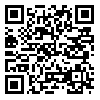Sun, Dec 29, 2024
[Archive]
Volume 19, Issue 2 (June-Biomaterials Special Issue- 2022)
IJMSE 2022, 19(2): 1-13 |
Back to browse issues page
Download citation:
BibTeX | RIS | EndNote | Medlars | ProCite | Reference Manager | RefWorks
Send citation to:



BibTeX | RIS | EndNote | Medlars | ProCite | Reference Manager | RefWorks
Send citation to:
Ghadirian H, Golshahi H, Bahrami S, Najafi F, Geramy A, Heidari S. Synthesis and Characterization of a Urethane Dimethacrylate Monomer Containing a Quaternary Ammonium Salt for Use as a Component of Orthodontic Adhesive Primer. IJMSE 2022; 19 (2) :1-13
URL: http://ijmse.iust.ac.ir/article-1-2810-en.html
URL: http://ijmse.iust.ac.ir/article-1-2810-en.html
Hannaneh Ghadirian 
 , Hamid Golshahi
, Hamid Golshahi 
 , Sara Bahrami
, Sara Bahrami 
 , Farhood Najafi
, Farhood Najafi 
 , Allahyar Geramy
, Allahyar Geramy 
 , Soolmaz Heidari
, Soolmaz Heidari 


 , Hamid Golshahi
, Hamid Golshahi 
 , Sara Bahrami
, Sara Bahrami 
 , Farhood Najafi
, Farhood Najafi 
 , Allahyar Geramy
, Allahyar Geramy 
 , Soolmaz Heidari
, Soolmaz Heidari 

Abstract: (7297 Views)
Quaternary ammonium compounds (QACs) are among the most commonly used antibacterial agents. The aim of this study was to synthesize a dimethacrylate monomer functionalized with a QAC and to study its effect on the properties of an orthodontic adhesive primer. Urethane dimethacrylate monomer functionalized with a QAC (UDMAQAC) was synthesized and then characterized by nuclear magnetic resonance spectroscopy (NMR) and Fourier transform infrared spectroscopy (FTIR). 5, 10, 15 and 20 wt% of UDMAQAC was added to an orthodontic adhesive primer (control group). FTIR analysis was used to measure the degree of conversion (DC). The bond strength of dental brackets was measured by shear bond strength (SBS) test and adhesive remaining index (ARI) was evaluated by stereomicroscope. Agar diffusion test and MTT assay were used to evaluate the antibacterial property and cell viability, respectively. Statistical analysis included one-way ANOVA with Tukey’s post hoc test and Kruskal-Wallis nonparametric test (P˂0.05). Although the obtained data did not show significant differences between the SBS and DC of different groups, but the highest values were obtained by adding 10 wt% monomer. Adding more than 10 wt% UDMAQAC resulted in significant increase in antibacterial property. The 15 and 20 wt% groups showed significantly lower cell viability
Type of Study: Research Paper |
Subject:
Synthesis and preparation of materials to meet the requirements of AM techniques
Send email to the article author
| Rights and permissions | |
 |
This work is licensed under a Creative Commons Attribution-NonCommercial 4.0 International License. |





